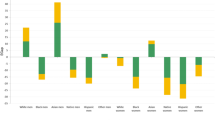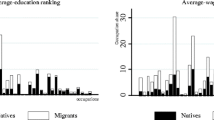Abstract
Data are presented in this article indicating that the disparity in the earnings of blacks and whites in upper level white-collar occupations is greater than that between their counterparts in blue-collar occupations. Moreover it appears that very little of the racial earnings differences in either occupational category can be explained by so-called human capital differences.
Similar content being viewed by others
Notes
See, e.g., William A. Sampson, “New Insights on Black Middle-Class Mobility,”The Urban League Review 5 (Summer 1980): 21–41; William Julius Wilson,The Declining Significance of Race (Chicago: University of Chicago Press, 1981); idem.The Truly Disadvantaged (Chicago: University of Chicago Press, 1987); James P. Smith and Finis Welch,Closing the Gap: 40 Years of Black Economic Progress (Santa Monica, Calif: The Rand Corporation, February 1986); Joseph Perkins, “Boom Time for Black America: The Middle Class is Surging Under Reagan,”Policy Review (Summer 1988): 26–28; Bennett Harrison, “Individual Wages and the Growth of the Black Middle Class,” Unpublished manuscript, (Massachusetts Institute of Technology, 1988). It is interesting to note, however, that this latest approbation and optimism is in marked contrast to the earlier excoriations of the black middle class made by E. Franklin Frazier in his landmark study in the 1950s,Black Bourgeoisie. Franklin not only scorned the lifestyle and pretensions of the black middle class but also noted the fragility, insecurity and inconsequentiality of their economic position here in America.
There is a notable exception to the upbeat assessments of the recent economic progress of the black middle class. Bart Landry, in his book,The New Black Middle Class (Berkeley, Calif.: University of California Press, 1988), reaches many of the same quantitative as well as qualitative conclusions as the present article regarding the current relative economic vulnerability of the black middle class.
A problem for black professionals generally has been the fact that a greater proportion than whites are employed in the relatively lower-paying public sector even though, somewhat paradoxically, public sector employment for blacks has been more remunerative and afforded greater opportunities for advancement than private sector employment. However, cuts in the federal budget and workforce mandated during the Reagan years have had a disproportionately negative effect on black professionals(Ibid., pp. 121–22). It is also interesting to note the “perverse” interdependence of the black middle class and black underclass. As William Darity, Jr. and Samuel Myers, Jr. point out in “Do Transfer Payments Keep the Poor in Poverty?”American Economic Review Proceedings, Volume 77 (1987), p. 221, “.. .the occupational status of the (black) middle class is contingent on the continued maintenance of the underclass as an underclass and the continued existence of the prevailing scheme of social welfare programs, regardless of their effectiveness.”
These are derived by inserting the mean years of schooling from Table 7 in the schooling partial derivatives of the previous footnote.
See Jeremiah Cotton, “Decomposing Income, Earnings, and Wage Differentials: A Reformulation of Method,”Sociological Methods and Research 14 (November 1985): 201–16; idem. “More on the ‘Cost’ of Being a Black or Mexican American Male Worker,”Social Science Quarterly 66 (December 1985): 867-85; idem. “Discrimination and Favoritism in the U. S. Labor Market: A Cost/Benefit Analysis of Sex and Race,”The American Journal of Economics and Sociology 47 (January 1988); idem. “On the Decomposition of Wage Differentials,”The Review of Economics and Statistics 70 (May 1988): 236-43.
See note 1.
Ibid.
About this article
Cite this article
Cotton, J. The gap at the top: Relative occupational earnings disadvantages of the black middle class. Rev Black Polit Econ 18, 21–38 (1990). https://doi.org/10.1007/BF02717873
Issue Date:
DOI: https://doi.org/10.1007/BF02717873




